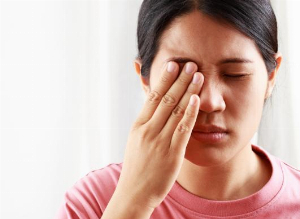Cluster Headaches: Everything you need to know
Published Aug 21, 2023 • By Somya Pokharna
Cluster headaches are a testament to the lengths of pain the human body can endure. These aren’t just any headaches – They strike suddenly and swiftly, and are distinguished by their unique cyclical patterns, aptly named cluster periods, which bring excruciating pain to those affected.
But why do they occur? What are the symptoms and how can they be treated?
Discover all about them in this article!

What are cluster headaches?
Cluster headaches are one of the most severe and agonizing types of headaches. They tend to occur in cyclical patterns or cluster periods, hence the name. They often show up at the same time each day, and each attack can last about 1 to 3 hours on average. The intense pain in or around one eye on one side of the head during an attack can easily awaken an individual in the middle of the night. The cluster periods are followed by remissions where there are no headaches, and these can last for a couple of months. Although they are often confused with migraines, cluster headaches can be much more excruciating, recurring frequently and disrupting a person's life for weeks or even months at a time.
Cluster headaches are relatively rare when compared with other types of headaches, affecting about 1 in 1,000 people worldwide. They typically start when a person is in their 30s or 40s, and men are more prone to them than women.
Why do cluster headaches occur?
The exact origins of cluster headaches remain a mystery to researchers. However, the hypothalamus, a small area of the brain responsible for regulating various neurobiological functions, has been observed to be active during cluster attacks. There also appears to be a correlation between these headaches and the abrupt discharge of histamine or serotonin within the body.
Several factors have been identified as potential triggers for cluster headaches, including the consumption of alcohol or nicotine, transitions to high altitudes, exposure to intense illumination, physical activities or exertion, exposure to strong smells, such as perfume or paint, heightened temperatures stemming from weather conditions or hot baths, and the consumption of foods rich in nitrates, like processed meats (ham, bacon, etc.). Furthermore, even cocaine usage has been implicated as a potential trigger for these debilitating headaches. There may also be a genetic link, since some people who get cluster headaches have other family members who also get them.
What are the symptoms of cluster headaches?
Before the start of a cluster headache, an individual may experience slight discomfort or a burning feeling on one side of their head. However, cluster headaches often come on fast, and symptoms usually only take 5 to 10 minutes to set in, leaving little time to prepare.
Individuals experiencing a cluster headache might also exhibit signs of restlessness or agitation. Moreover, red or teary eyes, nasal congestion, and sweating on the forehead are common co-occurrences of these headaches. Another notable symptom is eyelid drooping or swelling, adding to the distinctive profile of cluster headaches that separates them from other types of headaches and pains.
How can cluster headaches be treated?
Although cluster headaches can have a significant impact on an individual’s quality of life and there is no permanent cure for them, they are fortunately not life-threatening. Moreover, medications and treatments can make the attacks shorter and less severe and reduce the number of clusters that a person experiences.
The pain of these headaches builds up so quickly and to such an excruciating peak that most painkillers that are designed to be ingested, like paracetamol, do not work quickly enough.
The most rapid and successful treatment of a cluster attack is a self-administered injection, just beneath the skin, of a drug called sumatriptan. However, this drug can be costly, and therefore, many physicians and neurologists are sometimes reluctant to prescribe it.
Sumatriptan can be inhaled through the nose using a nasal spray as well, but it is much less effective than injecting beneath the skin. Zolmitriptan taken in 5mg tablet form can also possibly help with pain in some individuals.
Another very effective treatment for rapid pain relief is oxygen therapy, wherein patients’ breath in pure oxygen at a rate of between 7 to 15 liters per minute. It should be inhaled continuously for 15-20 minutes using a non-breathing mask i.e., one without holes.
Lidocaine in liquid form can also be given as either nose drops or nasal spray, deep in the nostril on the painful side to bring mild to moderate relief.
A gamma core device is a recently trialed hand-held electronic device which emits a pulse when applied to the vagal nerve in the neck to help relieve pain.
Can cluster headaches be prevented?
Apart from avoiding triggers, individuals can also use medications to prevent cluster headaches. These need to be prescribed by the doctor, to be taken as soon as the headaches start and continued until the bout subsides.
A primary preventive option is a medication named verapamil. It's taken as tablets multiple times a day. Since verapamil can affect the heart in some cases, regular monitoring with an electrocardiogram (ECG) is necessary.
If verapamil doesn't prove effective, alternative treatments might be considered. These could involve corticosteroids, lithium medication, or local anesthetic injections at the back of the head.
Key takeaways
In conclusion, cluster headaches present as some of the most intense and agonizing forms of head pain. Their cyclical occurrence during cluster periods, often at consistent times each day, inflicts severe discomfort, typically lasting 1 to 3 hours per attack. The distinctive pain around one eye and the disruption to sleep can be deeply distressing. Although relatively rare, these headaches can significantly disrupt lives for weeks or months.
While the exact cause is unknown, various factors, from alcohol and strong smells to genetic predisposition, might trigger an attack.
Managing cluster headaches involves rapid-response treatments. Though a cure remains undiscovered, the combination of preventive measures and effective treatments can offer hope for those enduring the challenges of cluster headaches.
Share your thoughts and questions with the community in the comments below!
Take care!

 Facebook
Facebook Twitter
Twitter


